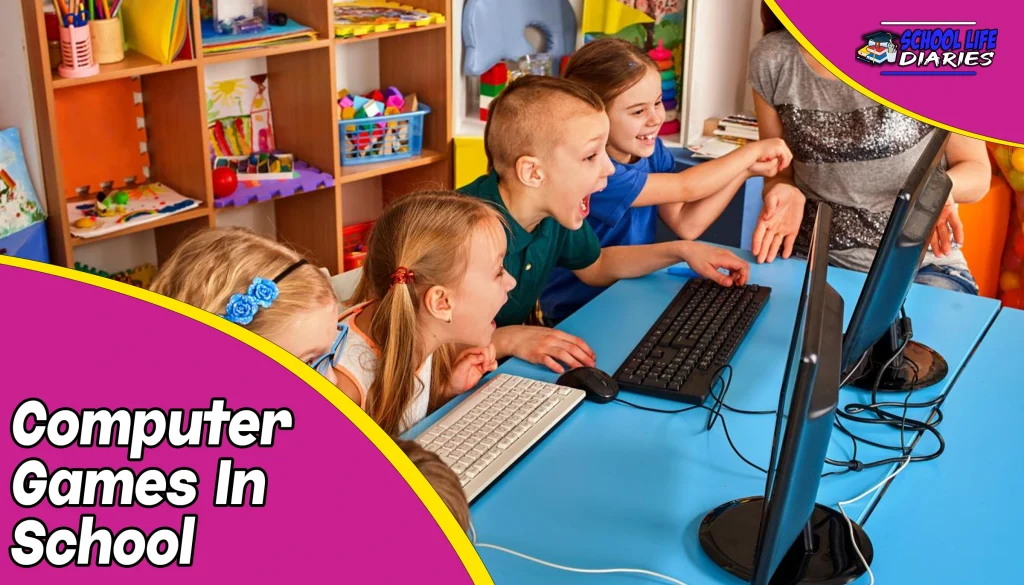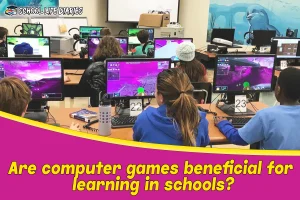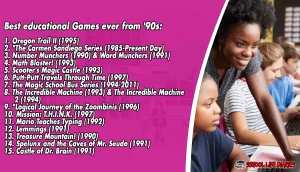Computer games have become increasingly prevalent in schools as educators recognize their potential benefits for learning. However, along with these advantages come certain disadvantages that need to be carefully considered.
Many studies have shown that well-designed educational computer games can enhance critical thinking skills, problem-solving abilities, and creativity among students. These games often provide immersive experiences that allow learners to explore complex concepts in a hands-on and enjoyable manner.
Are computer games beneficial for learning in schools?
Computer games have been a subject of debate regarding their potential benefits for learning in schools. On one hand, proponents argue that computer games can enhance student engagement and motivation, leading to improved academic performance. They believe that the interactive nature of these games can make learning more enjoyable and dynamic, encouraging students to actively participate in the educational process.
One of the main advantages of using computer games in schools is their positive impact on student engagement. Traditional teaching methods often struggle to capture students’ attention and maintain their interest throughout the lesson. Despite the potential benefits they offer, it is important to consider the cons associated with using computer games in schools as well. Some critics argue that excessive reliance on technology may hinder social interaction among students and limit their ability to develop essential interpersonal skills.
Do educational computer games require specific hardware or software?
Utilizing appropriate hardware and software is essential for facilitating the effective implementation of educational computer games in academic settings, thus enabling a more engaging and immersive learning experience. Specific hardware requirements may vary depending on the complexity of the game and its intended purpose. Some educational computer games may require specialized input devices, such as game controllers or interactive whiteboards, to enhance user interaction and optimize learning outcomes.
In terms of required software, educational computer games often rely on specific programs or platforms that are designed to support their functionalities. These can include game engines or development environments that allow educators to create customized content or modify existing games according to their curriculum objectives.
What are some success stories of schools effectively using computer games for learning?
Implementing educational computer games in academic settings has resulted in numerous success stories, showcasing the positive impact of these digital tools on student learning outcomes. One notable success story comes from Quest to Learn, a public school in New York City that employs game-based learning across all subjects. The school has reported higher levels of engagement and motivation among students, leading to improved academic performance.
Another success story can be found at the PlayMaker School in Los Angeles. This innovative school uses Minecraft as a tool for teaching various subjects such as math, science, and history. By allowing students to explore and build within the virtual world of Minecraft, teachers have found that students are more actively involved in their own learning process. They become immersed in solving complex problems related to real-world issues and develop creativity and teamwork skills along the way.
These success stories highlight how effectively implementing educational computer games can have a positive impact on student learning outcomes. From improved engagement and motivation to enhanced critical thinking skills and subject knowledge acquisition, these digital tools offer unique opportunities for educators to create dynamic learning experiences that resonate with today’s tech-savvy generation of learners.
Best educational Games ever from the ’90s :
One of these is Oregon Trail II, which was released in 1995 and allowed players to experience life as a pioneer on the historic Oregon Trail. Another popular game from this era is ‘The Carmen Sandiego Series,’ which began in 1985 and continues to be enjoyed by students today. Number Munchers (1990) and Word Munchers (1991) are also noteworthy games that helped children develop their math and language skills.
Oregon Trail II (1995)
This game, developed by MECC (Minnesota Educational Computing Consortium), aimed to teach students about the realities faced by American pioneers as they traveled westward during the 19th century.
Oregon Trail II allowed players to assume the role of a wagon leader and make decisions regarding supplies, routes, and interactions with Native Americans. With its engaging gameplay and historical context, this game offered several advantages for educational purposes. It fostered problem-solving abilities and taught students about cause-and-effect relationships within a historical context.
Oregon Trail II was one example of an educational computer game from the ’90s that offered both advantages and disadvantages for learning purposes in schools. While it provided an engaging way for students to learn about American pioneer history and fostered critical thinking skills, it also had limitations such as potential stereotyping or oversimplification of historical events.
“The Carmen Sandiego Series (1985-Present Day)
The Carmen Sandiego series, which debuted in 1985 and continues to this day, offers students an interactive and visually captivating experience that engages them in the pursuit of geographical knowledge and problem-solving skills.
One of the strengths of the Carmen Sandiego series is its ability to seamlessly integrate history and culture into gameplay. As players follow Carmen’s trail across different regions, they encounter historical events and cultural references specific to each location. This not only enhances their understanding of global history but also fosters an appreciation for diverse cultures. They have to gather information from various sources such as maps, newspapers, and interviews with witnesses in order to piece together her whereabouts.
The Carmen Sandiego series provides an engaging platform for students to explore global geography while simultaneously developing problem-solving skills. Its interactive nature allows for active learning where students can actively apply their knowledge rather than passively receiving information. This approach also encourages critical thinking, problem-solving, and collaboration skills as students navigate through historical scenarios and make decisions based on their understanding of the context.
Number Munchers (1990) & Word Munchers (1991)
Number Munchers (1990) and Word Munchers (1991) revolutionized educational gaming by providing students with engaging platforms to enhance their numeracy and literacy skills. These computer games were designed to make learning fun and interactive, allowing students to practice key concepts in an enjoyable way. The impact of computer games on learning has been found to be positive. Research has shown that educational computer games can improve student engagement, motivation, and retention of information.
It is crucial for educators to carefully select educational computer games that cover relevant topics and skills outlined in the curriculum. Another challenge is overcoming any resistance from teachers or administrators who may view computer games as mere entertainment rather than valuable educational tools.
Number Munchers (1990) and Word Munchers (1991) have had a significant impact on educational gaming by providing engaging platforms for enhancing numeracy and literacy skills. The benefits of these educational computer games include hands-on learning experiences, improved student engagement, and motivation, as well as immediate feedback on performance.
Math Blaster! (1993)
Math Blaster! (1993) revolutionized educational gaming by introducing a dynamic and interactive platform that enhanced students’ mathematical skills through immersive gameplay.
One of the key educational benefits of Math Blaster was its ability to make math concepts more accessible and relatable to students. Through its captivating storyline and gameplay mechanics, the game effectively presented mathematical problems in a practical context, allowing students to see the real-world applications of these concepts.
The gaming experience offered by Math Blaster went beyond traditional classroom instruction by providing a sense of autonomy and freedom for students. Unlike conventional methods of teaching that often follow a rigid structure, this game gave students the opportunity to explore different levels at their own pace and discover new strategies for solving math problems.
The element of competition also motivated students to improve their skills and achieve higher scores, fostering a sense of achievement and self-confidence. Math Blaster! (1993) was a groundbreaking educational game that revolutionized the way mathematics was taught in schools. Its interactive platform combined with engaging gameplay not only enhanced students’ mathematical skills but also made learning enjoyable.
Scooter’s Magic Castle (1993)
Immersed in a magical world, Scooter’s Magic Castle (1993) transported players to a whimsical realm where they could embark on enchanting quests and unlock hidden treasures. This educational computer game captivated students with its engaging storyline and interactive gameplay. By incorporating educational content into the game, Scooter’s Magic Castle provided an effective platform for learning while keeping students entertained.
This computer game allowed them to explore at their own pace and make independent decisions. Students had the freedom to choose which tasks they wanted to tackle first or how much time they wanted to spend on each activity. This sense of autonomy empowered them, giving them a subconscious desire for freedom in their education. Scooter’s Magic Castle (1993) served as an excellent example of how computer games can have educational benefits in schools.
Putt-Putt Travels Through Time (1997)
Traveling back in time, Putt-Putt Travels Through Time (1997) transported players to different historical eras, allowing them to embark on exciting adventures and discover fascinating facts. This computer game was a success story among educational games of its time, captivating young learners with its engaging gameplay and interactive storytelling.
Putt-Putt Travels Through Time (1997) was a notable example of an educational computer game that effectively blended fun and learning. Its success stories can be attributed to its engaging gameplay, which allowed players to travel back in time and explore various historical eras. With only basic hardware requirements, this game provided valuable learning benefits by imparting knowledge about different cultures and fostering critical thinking skills in an interactive manner.
The Magic School Bus Series (1994-2011)
The Magic School Bus Series (1994-2011) captivated young learners with its interactive and educational content, allowing them to explore various scientific concepts and phenomena through engaging storytelling. This computer game series had a significant educational impact on children as it provided them with an opportunity to learn in a fun and interactive way. By immersing themselves in the world of the Magic School Bus, students were able to grasp complex scientific ideas more easily and retain information for longer periods of time.
The Magic School Bus Series had a profound educational impact on young learners by providing them with an interactive learning experience. Its engaging storytelling approach allowed children to explore various scientific concepts while developing important skills such as critical thinking and problem-solving.
The Incredible Machine (1993) & The Incredible Machine 2 (1994)
One notable aspect of The Incredible Machine and its sequel, The Incredible Machine 2, is their innovative approach to problem-solving through the use of interactive puzzles and contraptions. These games revolutionized the puzzle genre by allowing players to create complex machines to solve various challenges. The gameplay mechanics were unique and engaging, encouraging players to think critically and creatively.
They provided an entertaining platform for learning about physics principles and problem-solving strategies. Players were encouraged to apply scientific concepts in practical ways as they constructed intricate machines. Through trial and error, they gained an intuitive understanding of cause-and-effect relationships and learned how different elements interacted with one another.
This hands-on approach to learning made complex topics more accessible and enjoyable for students who may have struggled with traditional teaching methods. Overall, The Incredible Machine series demonstrated the potential of computer games in schools by combining entertainment with educational content in a way that engaged students’ minds while fostering critical thinking skills.
“Logical Journey of the Zoombinis (1996)
Logical Journey of the Zoombinis (1996) introduced players to a captivating and intellectually stimulating world where they were challenged to guide these lovable creatures through a series of puzzles that tested their logical reasoning and problem-solving skills. The game mechanics of Zoombinis involved analyzing patterns, making logical connections, and finding solutions by applying deductive reasoning.
The educational value of Zoombinis was evident as it provided an engaging platform for students to develop important cognitive abilities. By engaging with complex puzzles, students were able to enhance their logical thinking skills, which are crucial for problem-solving in many academic disciplines.
This iterative process not only enhanced their decision-making abilities but also taught them the importance of persistence and adaptability in overcoming obstacles. Zoombinis had a positive impact on students by providing them with an enjoyable learning experience that promoted critical thinking and problem-solving skills. The game’s interactive nature allowed students to actively engage with the content while having fun at the same time. This increased motivation and enthusiasm for learning, as it tapped into their subconscious desire for freedom and autonomy.
Mission: T.H.I.N.K. (1997)
Mission: T.H.I.N.K. (1997) expanded on the success of its predecessor by providing students with a challenging and intellectually stimulating experience that fostered critical thinking and problem-solving skills.
One of the main benefits of incorporating educational computer games like Mission: T.H.I.N.K. into school curricula is the development of critical thinking skills. As students navigate through the game’s missions, they are required to identify patterns, evaluate options, and make decisions based on logical reasoning.
Incorporating computer games like Mission: T.H.I.N.K. into schools can be an effective way to promote critical thinking skills while engaging students in a fun and interactive learning environment. By encouraging intellectual stimulation through gameplay, these educational tools have the potential to enhance students’ problem-solving abilities and equip them with valuable cognitive skills that can be applied beyond the virtual world.
Mario Teaches Typing (1992)
Mario Teaches Typing (1992) revolutionized the way individuals learn typing skills by incorporating the beloved character of Mario and his adventures, captivating learners and evoking a sense of excitement and motivation. This computer game introduced a fun and interactive approach to teaching typing, making it more engaging for students.
The benefits of computer games in education are numerous. When students are actively engaged in their learning, they are more likely to retain information and develop important skills. Mario Teaches Typing (1992) was groundbreaking in its integration of popular characters into educational computer games. The benefits of using such games in education include increased engagement, personalized learning experiences, and immediate feedback for students.
Lemmings (1991)
The game Lemmings (1991) introduced a unique concept where players must guide a group of small creatures through various obstacles and challenges, highlighting the importance of problem-solving skills in a visually stimulating environment. The impact of Lemmings on education lies in its ability to foster critical thinking and strategic planning among students.
In terms of gameplay and mechanics, Lemmings offered an innovative experience for players. The game required quick decision-making as players had to assign different skills to individual lemmings, such as building bridges or digging tunnels, in order to overcome obstacles. Lemmings also holds cultural significance as one of the pioneering computer games that gained widespread popularity during the 1990s. Its engaging style captured the attention of gamers around the world, making it an influential title within the gaming industry.
Treasure Mountain! (1990)
Treasure Mountain! (1990) introduced players to an immersive and captivating world where they must navigate through various challenges and puzzles, providing an enjoyable and engaging experience. The game is designed to enhance learning in schools by incorporating educational content within the gameplay.
One of the advantages of using Treasure Mountain! (1990) in schools is its ability to make learning fun and interactive. By disguising educational content as a game, students are more likely to be motivated and engaged in their learning process. The game’s immersive environment and captivating storyline create a sense of excitement that can help students stay focused on their tasks for longer periods of time.
One potential drawback is that excessive reliance on computer games may lead to reduced face-to-face interaction among students or between students and teachers. While the game can enhance individual learning experiences, it may hinder opportunities for collaborative problem-solving or social interactions that are essential for developing interpersonal skills.
Treasure Mountain! (1990) has shown promise in enhancing learning experiences in schools by introducing an engaging and interactive platform for education. Its ability to make learning fun while reinforcing important academic concepts can contribute positively towards student engagement and motivation.
Spelunx and the Caves of Mr. Seudo (1991)
Spelunx and the Caves of Mr. Seudo (1991) presents players with a captivating and immersive world filled with challenging puzzles and interactive gameplay. The game revolves around exploring caves and solving various problem-solving challenges to progress through the storyline. As players navigate through the mysterious underground caverns, they encounter intricate riddles and mind-bending puzzles that test their critical thinking skills and encourage them to think outside the box.
One of the main strengths of Spelunx is its interactive storytelling, which keeps players engaged throughout their journey. The game introduces a compelling narrative that unfolds gradually as players delve deeper into the caves. The game’s puzzles require logical reasoning, spatial awareness, pattern recognition, and experimentation.
Spelunx and the Caves of Mr. Seudo (1991) provides an engaging experience for players through its exploration of caves, problem-solving challenges, and interactive storytelling elements. By immersing players in a mysterious underground world filled with intriguing puzzles, it captivates their attention while fostering critical thinking skills.
Castle of Dr. Brain (1991)
Castle of Dr. Brain (1991) offers players an intellectually stimulating experience through its challenging puzzles and problem-solving gameplay. The game presents a variety of mind-bending challenges that require critical thinking skills and logical reasoning to overcome. Players are tasked with navigating through the castle’s rooms, each filled with unique puzzles and brain teasers that test their knowledge in various subjects such as math, science, logic, and language arts.
The success of Castle of Dr. Brain lies in its ability to seamlessly integrate educational content into a captivating gaming experience. By incorporating educational concepts into the gameplay, the game effectively engages students in learning without them even realizing it. This integration has led to the inclusion of Castle of Dr. Brain in school curricula as an innovative tool for teaching and reinforcing academic concepts. The impact of Castle of Dr. Brain on student engagement cannot be overstated. The game provides a refreshing break from traditional classroom activities and introduces a sense of excitement into the learning process.
Conclusion
Computer games have become increasingly popular in schools as a tool for learning. While there are advantages to using computer games in the classroom, there are also some disadvantages that need to be considered.
One advantage of incorporating computer games into education is that they can make learning more engaging and interactive. These games often require problem-solving skills, critical thinking, and decision-making, which are important for students to develop. With the presence of technology, students may be tempted to deviate from their educational tasks and engage in non-academic activities instead.
In conclusion, while computer games can offer several benefits for learning in schools such as increased engagement and personalized learning experiences, there are also drawbacks such as potential distractions and limited access to appropriate technology. Therefore, it is essential for educators to carefully consider these advantages and disadvantages before integrating computer games into their curriculum.







